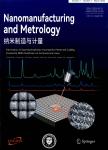Patterning Functionalized Surfaces of 2D Materials by Nanoshaving
作者机构:School of PhysicsTrinity College DublinDublin 2 D02 PN40Ireland AMBER CentreCRANN InstituteTrinity College DublinDublin 2Ireland Institute of PhysicsEIT 2Faculty of Electrical Engineering and Information TechnologyUniversitat der Bundeswehr Miinchen85579 NeubibergGermany School of ChemistryTrinity College DublinDublin 2Ireland
出 版 物:《Nanomanufacturing and Metrology》 (纳米制造与计量(英文))
年 卷 期:2022年第5卷第1期
页 面:23-31页
核心收录:
学科分类:081704[工学-应用化学] 07[理学] 08[工学] 0817[工学-化学工程与技术] 070303[理学-有机化学] 0703[理学-化学]
基 金:Science Foundation Ireland PI_15/IA/3131 Georg Stefan Duesberg
主 题:Nanoshaving AFM KPFM Perylene diimide 2D materials MoS_(2) WS_(2) Noncovalent functionalization
摘 要:Atomic force microscopy(AFM)and scanning probe lithography can be used for the mechanical treatment of various surfaces,including polymers,metals,and *** technique of nanoshaving,in which materials are removed using the AFM tip,is employed in this work to produce nanopatterns of self-assembled monolayers(SAMs)on two-dimensional(2D)*** materials used are monolayers of transition metal dichalcogenides(TMDs),namely,MoS_(2)and WS_(2),which are noncovalently functionalized with perylene diimide(PDI),a perylene *** approach involves rastering an AFM probe across the surface at a controlled increased load in ambient *** a result of the strong bond between PDI SAM and TMD,loads in excess of 1|1N are required to pattern the *** predefined patterns,including a grating pattern with feature sizes below 250 nm,are *** indicate the high precision of nanoshaving as an accurate and nondestructive lithographic technique for 2D *** work functions of shaved heterostructures are also examined using Kelvin probe force microscopy.



